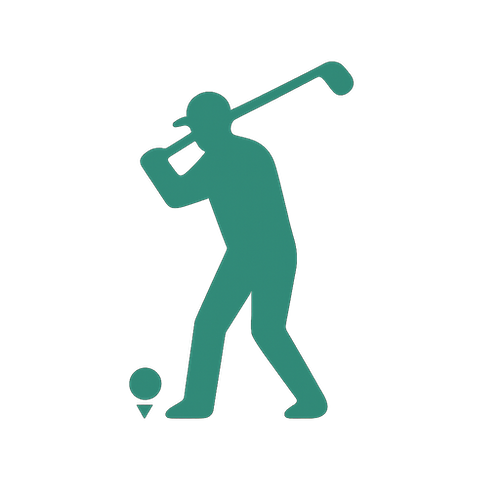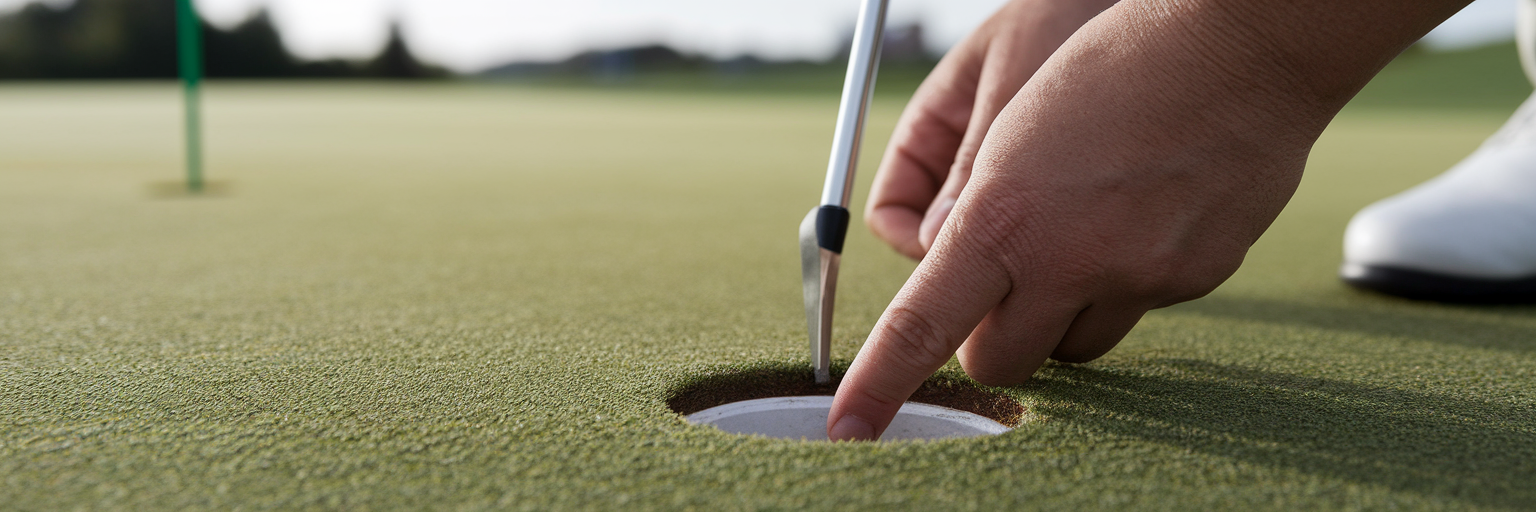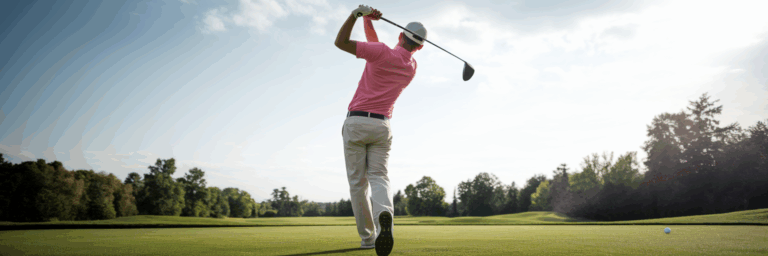Ihr erster Leitfaden zur Golfplatz-Etikette
Golf has been played for centuries, guided by an unwritten code of conduct that ensures respect and enjoyment for all. This code, known as etiquette, is the foundation of the game's sportsmanship.
Why Good Manners Matter in Golf
Many newcomers feel a little anxious about all the "rules" on a golf course. But golf etiquette for beginners isn't about a strict list of dos and don'ts. Instead, it’s a tradition built on three simple ideas: showing respect for other players, caring for the course itself, and keeping a good pace so everyone can enjoy their round.
Think of it as the shared understanding that makes the game work smoothly. When you know the basics, you stop worrying about making a social mistake. This frees you up to relax, feel confident, and focus on what truly matters: learning wie man Golf spielt and having a great time doing it.
Keeping Everyone Safe on the Course
Before anything else, safety comes first. A golf ball and club moving at high speed can be dangerous, so being aware of your surroundings is non-negotiable. These fundamental on course golf rules are designed to prevent accidents and ensure everyone from your group to the players on the next fairway stays out of harm's way.
Here are the four most important safety actions to remember:
- Check Your Surroundings: Before you even think about swinging, always take a full look around you. Make sure no one is standing too close, in front of you, or in the potential path of your ball.
- Shout "Fore!": If your ball is heading toward another person, shout "Fore!" as loudly as you can. This is the universal warning in golf that a stray ball is in the air. Don't be shy; a loud shout is a helpful one.
- Stand in a Safe Spot: When someone else is hitting, stand still, stay quiet, and position yourself out of their line of sight. The best place is typically behind the player and to the side.
- Control Your Practice Swings: Take practice swings away from others. Even without a ball, a moving club requires space. Make sure your swings are controlled and that you are not kicking up debris that could hit someone.
Aufrechterhaltung des Spieltempos
Have you ever been stuck in a slow-moving queue? The same feeling can happen on a golf course. "Pace of play" refers to the time it takes to complete a round, with most courses aiming for about four hours for 18 holes. Slow play creates a frustrating bottleneck for every group behind you. To avoid this, many golfers embrace "Ready Golf." This modern approach means you hit when you are ready, as long as it is safe, rather than strictly waiting for the person furthest from the hole to play first.
Here are a few simple pace of play golf tips to keep things moving:
- Limit your practice swings to one or two.
- Plan your next shot and select your club while you walk to your ball.
- Place your golf bag or park your cart in a position that allows for a quick exit to the next tee.
- If your group is consistently waiting on every shot and there is open space ahead of you, it is courteous to let a faster group behind you "play through." Just wave them forward and wait for them to pass.
| Situation | Slow Play Habit | Ready Golf Solution |
|---|---|---|
| Preparing for Your Shot | Waiting until it's your turn to choose a club and read the green. | Choose your club and plan your shot while others are hitting. |
| Walking to Your Ball | Walking slowly or waiting for others in your group. | Walk directly to your own ball at a reasonable pace. |
| On the Putting Green | Marking, cleaning, and reading your putt only after others have finished. | Read your putt while others are putting, so you are ready when it's your turn. |
| After Finishing a Hole | Tallying scores and cleaning clubs at the green. | Move to the next tee box, then record scores while the next group plays. |
Showing Respect for Fellow Players
Golf is a game of focus, and the golden rule is to remain still and silent while another player is taking their shot. Even a small movement in their peripheral vision or a quiet whisper can be a major distraction. This courtesy extends to the putting green, which is considered a particularly sensitive area.
Be mindful of the "putting line." As the PGA often emphasizes, a player's putting line is the imaginary path their ball will take to the hole. Stepping on this line can subtly alter the putting surface, so always walk around it. Beyond silence, showing respect includes positive interactions. Compliment a good shot, and if a player loses a ball, help them look for it, but only for a maximum of three minutes to maintain pace.
Finally, a note on modern etiquette: keep your phone on silent. If you must take a call or send a message, step away from the group and do so quickly and discreetly. This ensures the game remains an escape for everyone.
Caring for the Golf Course
A beautiful golf course is a shared space, and every player has a responsibility to leave it in the same or better condition than they found it. This is not just about being tidy; it is about preserving the playing surface for everyone who comes after you. Think of yourself as a temporary caretaker during your round.
Repairing Divots
A divot is the piece of turf that is displaced when you hit the ball with an iron. Repairing divots on course is simple. If the piece of turf is intact, just pick it up, place it back in the hole like a puzzle piece, and press down firmly with your foot. If the divot explodes into small pieces, use the sand and seed mixture provided on your cart or at the tee box to fill the hole.
Fixing Pitch Marks
A pitch mark is the small dent your ball makes when it lands on the soft surface of the putting green. An unrepaired mark can damage the green for weeks. To fix it, insert a divot tool just outside the back of the mark and gently push the turf toward the center. Repeat this from all sides, then gently tap the repaired spot with your putter to smooth it out.
Raking Bunkers
Bunkers, or sand traps, require special care. Always enter and exit a bunker from its lowest point to avoid damaging the steep edges. After hitting your shot, use the nearby rake to smooth over all your footprints and the area where your club hit the sand. The goal is to leave a perfectly smooth surface for the next player.
Dressing the Part for Confidence and Comfort
Golf dress codes are rooted in tradition, but they also serve a practical purpose: helping you feel like you belong and ensuring you are comfortable. Knowing what to wear for golf removes any uncertainty and lets you step onto the first tee with confidence. While rules can vary, most courses follow similar guidelines.
Here is a general checklist for appropriate golf attire:
- A collared shirt, such as a polo.
- Tailored slacks or shorts. Denim, cargo shorts, and athletic wear are typically not allowed.
- Proper golf shoes, which provide traction and support.
The most important tip is to check the course's website or call the pro shop ahead of time to confirm their specific dress code. Remember, modern golf apparel is designed with flexible, breathable fabrics that enhance comfort and allow for a full range of motion during your swing.
Your Etiquette Checklist for a Great Round
Feeling ready? Here is a quick summary of the key etiquette points to remember:
- Play "Ready Golf" to keep a good pace.
- Stay silent and still during others' swings.
- Repair your divots and pitch marks.
- Rake the bunker after your shot.
- Shout "Fore!" for any errant shots.
Mastering these simple habits will make you a welcome addition to any group. Now you can focus on the fun part: learning wie man Golf spielt and enjoying every moment on the course.









